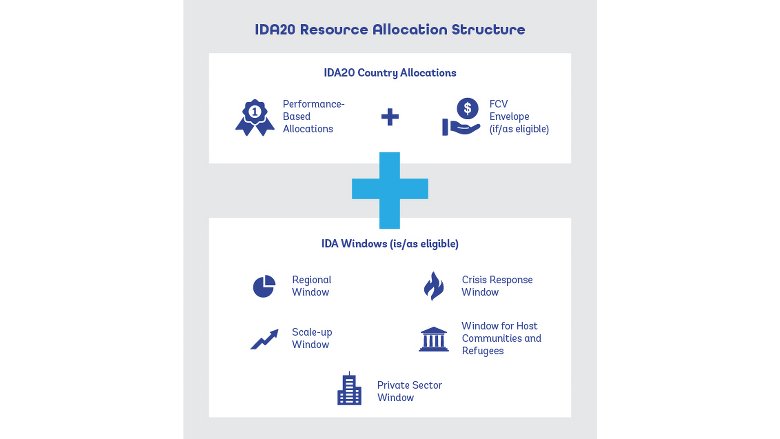IDA's 75 eligible recipients have very significant needs for concessional funds. But the amount of funds available, which is fixed once contributions are pledged by donor governments, tends to be well below the countries' needs. IDA, therefore, must allocate scarce resources among eligible countries. This is primarily done on the basis of recipients' policy performance and institutional capacity in order to concentrate resources where they are likely to be most helpful in reducing poverty.
Country allocations that provide unearmarked support to eligible countries serve as the foundation for IDA’s engagement, consisting of two-thirds of available resources in IDA20. The rest of IDA’s support in provided through a number of financing windows dedicated to addressing specific priority areas.
Eligibility
Two criteria are used to determine which countries can access IDA resources:
- Relative poverty defined as GNI per capita below an established threshold and updated annually (in fiscal year 2022: $1,255).
- Lack of creditworthiness to borrow on market terms and therefore a need for concessional resources to finance the country's development program.
Allocation Criteria
The main factor that determines the allocation of IDA resources among eligible countries is each country's performance in implementing policies that promote economic growth and poverty reduction. This is assessed by the Country Policy and Institutional Assessment (CPIA), which for the purposes of resource allocation is referred to as the IDA Resource Allocation Index (IRAI). The IRAI and portfolio performance together constitute the IDA Country Performance Rating (CPR). In addition to the CPR, population and per capita income also determine IDA allocations. Beginning 2005, the numerical IRAI, as well as the CPR, are disclosed.
To calculate Performance-Based Allocations (PBA), population and per capita income are taken into account together with the CPR. More details about the PBA process can be found in the IDA20 Replenishment Report (Annex 3). Starting in IDA19, the PBA is complemented by a new envelope of allocations for countries facing risks of fragility, conflict and violence (FCV).
IDA Windows
IDA makes additional resources available to countries through five dedicated financing windows and a reengagement set-aside. Each window is characterized by its own rules and eligibility criteria (please see the Annexes of the IDA20 Replenishment Report for details):
- The Regional Window promotes regional solutions to development challenges.
- The Crisis Response Window helps countries respond to severe unexpected natural, economic, or health disasters.
- The Scale-up Window provides additional financing on non-concessional terms for countries seeking greater resources for transformational projects.
- The Window for Host Communities and Refugees supports IDA countries to create development opportunities for both refugees and host communities.
- The Private Sector Window helps mobilize increased private sector investment in IDA countries, with a focus on fragile and conflict-affected states (FCS).
Last Updated: Mar 08, 2023


